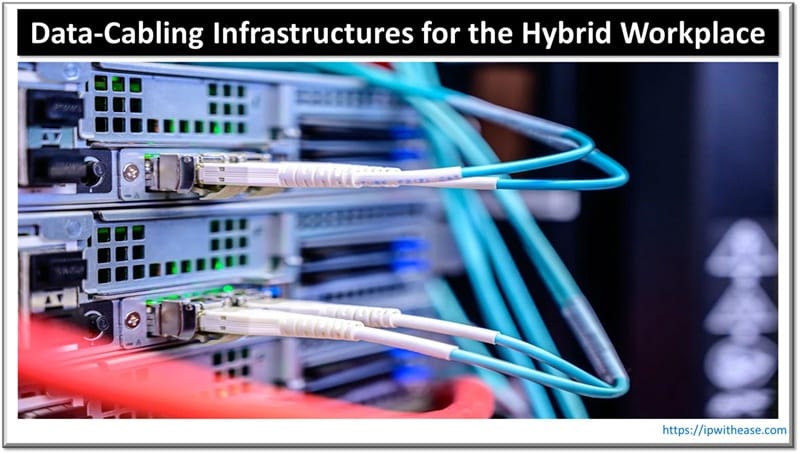Table of Contents
Corporate networks were once built around fixed desks and a predictable nine-to-five rhythm. Hybrid working has shattered that certainty. On any given day, an office may run at 30 % occupancy—or 110 % when project teams converge. Desk sharing, collaboration zones and “Zoom pods” create bursts of traffic your data cabling may never have envisaged. If patching routes, containment and labelling aren’t up to scratch, help-desk tickets spike and employee confidence dips. Worse, the business blames Wi-Fi or the ISP when, in truth, the problem lives beneath the raised floor.

Data Cabling Infrastructures for the Hybrid Workplace
Start with Objectives, not Cable counts
A capacity survey should translate business goals into technical metrics before anyone checks ceiling voids. Three questions anchor the discussion:
| Question | Why it matters | Typical outputs |
|---|---|---|
| What services are mission-critical? | Gives priority to low-latency apps (e.g., VoIP, VDI, CCTV) | Tiered resilience plan |
| How fast will headcount or device numbers grow? | Prevents premature obsolescence | Port density forecast |
| What sustainability targets exist? | Influences materials choice and disposal routes | Low-smoke zero-halogen spec, recycling plan |
Aligning cabling specification with these drivers keeps stakeholders engaged and protects the budget from arbitrary cuts.
When to favour Copper, When to leap to Fiber
Copper (Cat 6A and beyond) remains king for horizontal runs up to 90 m. It delivers 10 Gbps today and crucially supports PoE++ at 90 W, enough to power Wi-Fi 7 access points or pan-tilt-zoom cameras without local sockets. The economics are compelling: termination is quick and patching agile.
Fiber (OM4 multi-mode or OS2 single-mode) dominates risers, data-center trunks and sprawling campuses. Prices per meter have fallen markedly, and bend-insensitive cores make it installer-friendly. With 400 Gbps standards already ratified, fiber gives near-infinite headroom.
A hybrid approach fibre backbones, copper horizontals; therefore suits most UK workplaces. Reserve direct-to-desk fibre for specialist zones such as media-editing suites or quantitative-trading floors, where microseconds matter.
Containment: The Silent Determinant of Scalability
Cabling projects often stumble not on link performance but on pathway constraints. Five golden rules:
- Design for 40 % spare capacity at Day 1. Cable trays at 100 % fill invite disorder and expensive night-time retrofits.
- Segregate power and data by at least 200 mm, or use divider plates where closer proximity is unavoidable; BS 7671 insists on adequate separation to curb EMI.
- Choose modular basket with quick-release sections. Facilities teams can add spurs without hot works, eliminating permit delays.
- Plan for fire-stopping early. Every slab penetration needs tested intumescent pillows or collars; retro-fits after ceilings are painted cost triple.
- Label containment as well as cables. Future contractors will thank you and so will your risk assessor.
Small Lapses, Huge consequences
A single mis-pinned jack can impose 3–4 dB of return loss, enough to flip a marginal 10G link into failure. Insist on these practices:
- Tool calibration: Punch-down tools with depth stops set to manufacturer values; fusion splicers cleaned and OTDR-verified daily.
- Velcro not nylon ties: Maintains bundle shape without crushing pairs; nylon constricts over time.
- No untwist beyond 13 mm: Preserves differential signalling; check with gauge.
- Bend-radius discipline: 4× cable diameter for copper, 20× for fibre under pull, 10× at rest.
Testing Regime
A credible hand-over dossier includes:
- 100 % field-tester results (DSX-5000/8000 or equivalent) exported in native and PDF formats.
- OTDR traces for every fibre core.
- As-built drawings keyed to floor grids, not vague room names.
- Manufacturer warranty certificates—commonly 25 years—registered in the client’s name.
Without these artefacts, future disputes become a he-said-she-said quagmire.
Power over Ethernet: What rising wattage means for cabling
PoE devices once drew < 15 W; now LED luminaires and building-management controllers sip 60–90 W continuously. High current heats bundles, raising insertion loss and derating length. Mitigations include:
- Specifying larger conductor cables (23 AWG over 24 AWG).
- Spreading high-draw links across trays.
- Deploying Type 2 PoE switches with granular power polity.
BS 6701 mandates temperature derating tables; ignoring them courts mid-span brownouts and hardware failure.
Cable Management and Auditing: Keep order, Lower OPEX
A structured labelling convention e.g., FL-RACK-PORT paired with QR-coded patch panels slashes fault-finding time. Annual audits using handheld scanners capture moves/adds/changes in minutes, feeding directly into asset software. The modest upfront spend on intelligent patching often pays back within a year through reduced MTTR.
Sustainability: Cabling in the circular economy
UK firms face mounting ESG scrutiny. Practical steps:
- Choose Euroclass Cca or better for low smoke and reduced flame spread.
- Recycle copper off-cuts via certified handlers; copper fetches > £5,000 per tonne, offsetting project costs.
- Opt for halogen-free sheaths to minimise toxic emissions.
- Request manufacturer take-back schemes for reels and drums to curb site waste.
Documenting these actions strengthens tender submissions and corporate-social-responsibility reports.
5 Common Pitfalls and How to dodge them
| Pitfall | Consequence | Prevention |
|---|---|---|
| Value-engineering links below Cat 6A | Bottlenecks when Wi-Fi 7 arrives | Use TCO analysis, not capex alone |
| Mixing vendor ecosystems to shave cost | Warranty voids | Single-vendor end-to-end or verified open systems |
| Skipping sample pulls | Discovering tight bends after cable drums ordered | Early-phase pilot routes |
| Ignoring moves/adds protocol | Patch closets devolve into spaghetti | Simple change-log with barcode sign-off |
| Underestimating PoE cooling | Switch shutdowns in July heatwave | Thermal modelling and rack airflow management |
Future-Proofing: What the next five years will demand
- Wi-Fi 7 (320 MHz channels, Multi-Link Operation) will double backhaul expectations; plan dual Cat 6A per AP or single Cat 8.
- Single-Pair Ethernet will connect thousands of sensors over one twisted pair; reserve tray space and service loops.
- 400G campus backbones are moving from hyperscale to enterprise. MPO-16 or MPO-24 fibre trunks will normalise.
- AI at the edge means micro-data-centers in comms rooms. Cabling must support 25 kW per rack with structured power whips and fibre cross-connects.
Making runway for these shifts now avoids forklift upgrades later.
ABOUT THE AUTHOR
IPwithease is aimed at sharing knowledge across varied domains like Network, Security, Virtualization, Software, Wireless, etc.



